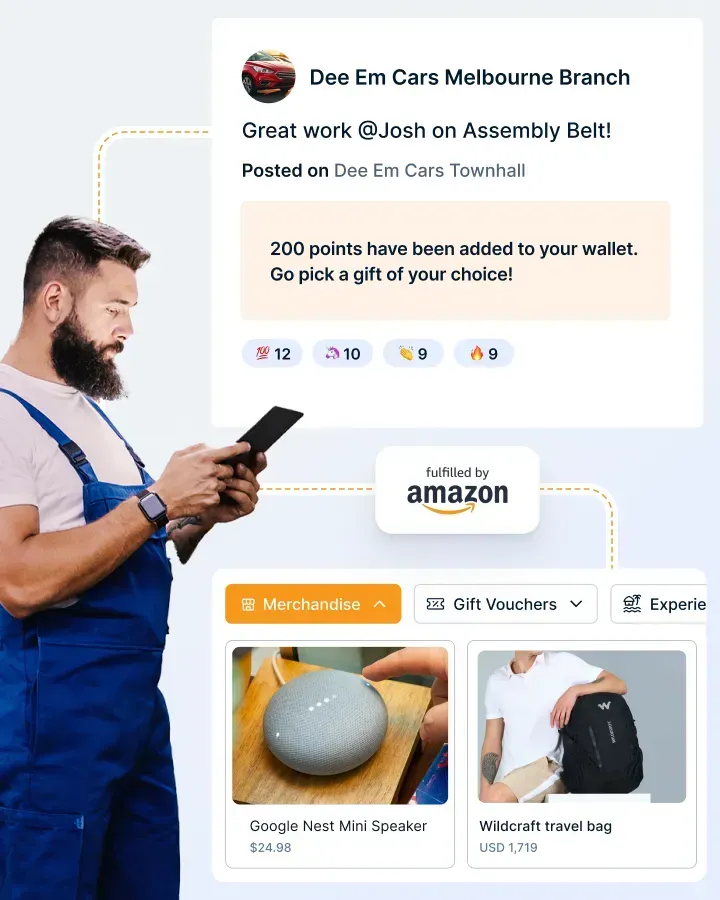14 Aktivitäten zur Mitarbeiterbindung für Angestellte, um sie zu motivieren und zu befähigen
Entdecken Sie 14 bewährte Aktivitäten zur Mitarbeiterbindung für Arbeiter, die Moral und Produktivität steigern. Lernen Sie Beispiele aus der Praxis kennen, um eine motivierte und engagierte Belegschaft zu schaffen.
Auf dieser Seite
Um das Engagement von Arbeitnehmern zu erhalten, bedarf es mehr als nur wettbewerbsfähiger Löhne. Ein positives Arbeitsumfeld, Anerkennung und Entwicklungsmöglichkeiten spielen eine wichtige Rolle für die Arbeitszufriedenheit und Produktivität. Im Gegensatz zu Büroangestellten profitieren Arbeiter von Tätigkeiten, die zu ihrem Tagesablauf und ihrem Arbeitsumfeld passen.
Eine gut geplante Strategie zur Mitarbeiterbindung stärkt die Moral des Teams, verringert die Fluktuation und erhöht die Effizienz. Einfache, aber wirksame Initiativen wie Schulungen, Wellness-Programme und Anerkennung durch Kollegen helfen den Mitarbeitern, sich wertgeschätzt und motiviert zu fühlen. Wenn die Bemühungen zur Mitarbeiterbindung auf ihre Bedürfnisse abgestimmt sind, entwickeln die Mitarbeiter eine stärkere Bindung an ihre Aufgaben und das Unternehmen.
Dieser Blog befasst sich mit Aktivitäten zur Mitarbeiterbindung für Arbeiter, die eine nachhaltige Wirkung erzielen. Ganz gleich, ob Sie Teams in der Fertigung, in der Logistik oder im Baugewerbe leiten, diese Strategien werden Ihnen helfen, eine engagiertere und produktivere Belegschaft aufzubauen.
Wer sind Arbeiter und warum sind sie wichtig?
Arbeiter führen manuelle Arbeiten aus, die je nach Art der Tätigkeit in ungelernte, angelernte oder gelernte Arbeit eingeteilt werden.
Indien galt lange Zeit als Land mit billigen Arbeitskräften, und die multinationalen Konzerne haben von dieser Kostenarbitrage profitiert, aber dieses Szenario ändert sich allmählich.
90% der Industrien haben einen akuten Arbeitskräftemangel festgestellt und beobachtet, dass mit dem Zugang zu Bildungssystemen staatliche Programme wie MNERGAimmer schwieriger wird, Ressourcen zu mobilisieren, um sich an Initiativen auf Arbeitnehmerebene zu beteiligen, was sich auf Produktion und Einnahmen auswirkt.
Neben diesen externen Faktoren verschärfen auch einige interne Faktoren das Problem des Engagements von Arbeitern. Faktoren wie ein großes Lohngefälle, sehr kontrollierte oder gefährliche Arbeitsbedingungen, monotone und körperlich anstrengende Arbeit, bei der der Schwerpunkt nicht auf Verbesserung oder Wachstum liegt, führen zu geringer Arbeitszufriedenheit und hohem Unengagement.
Die Abkopplung dieser Schicht ist weitaus schädlicher. Das zeigen die Indizien aus der Vergangenheit, wo Unternehmen wie Honda, Nokia und Maruti mit den negativen Auswirkungen von Arbeitsunruhen konfrontiert waren. Es gibt jedoch genügend Beispiele dafür, dass Unternehmen ihr Engagement anders definiert haben und daraus enorme Vorteile gezogen haben.
Daher müssen die Unternehmen ihren Umgang mit den Arbeitern ändern und nach neuen Wegen suchen oder die alten reformieren, um ein sinnvolles Engagement zu fördern.
Herausforderungen für Arbeiter und wie das Engagement der Mitarbeiter sie lösen kann
Arbeiter spielen in verschiedenen Branchen eine entscheidende Rolle, und ihre Aufgaben sind oft mit besonderen Herausforderungen verbunden. Das Engagement der Mitarbeiter kann dazu beitragen, viele dieser Herausforderungen zu bewältigen, indem es ein unterstützendes und motivierendes Arbeitsumfeld schafft. Hier sind fünf häufige Herausforderungen, mit denen Arbeiter konfrontiert sind, und wie Mitarbeiterengagement helfen kann:
1. Körperliche Anforderungen und Ermüdung
- Herausforderung: Arbeiterjobs erfordern oft anstrengende körperliche Arbeit, was zu Ermüdung und möglichen Gesundheitsproblemen führt.
- Wie das Engagement der Mitarbeiter hilft: Engagierte Mitarbeiter sind eher stolz auf ihre Arbeit, was zu einer besseren Selbstfürsorge und Einhaltung der Sicherheitsrichtlinien führt. Engagierte Mitarbeiter teilen auch eher mit, wenn sie Hilfe oder Anpassungen benötigen, was das Verletzungsrisiko verringert.
2. Fehlende Möglichkeiten der beruflichen Entwicklung
- Herausforderung: Arbeiter sehen oft nur begrenzte Möglichkeiten für den beruflichen Aufstieg, was zu Stagnation und Frustration führen kann.
- Wie das Engagement der Mitarbeiter hilft: Die Einbindung von Arbeitern beinhaltet das Angebot von Schulungsprogrammen und klaren Aufstiegsmöglichkeiten. Wenn Mitarbeiter eine Zukunft innerhalb des Unternehmens sehen, sind sie eher bereit, sich zu engagieren und zu motivieren.
3. Begrenzter Zugang zur Technologie
- Die Herausforderung: Viele Arbeiter haben nur begrenzten Zugang zu Technologie und Kommunikationsmitteln, was es schwierig macht, in Verbindung zu bleiben und sich zu informieren.
- Wie das Engagement der Mitarbeiter hilft: Die Einführung zugänglicher Kommunikationskanäle, wie regelmäßige Teambesprechungen oder mobile Apps, kann helfen, diese Lücke zu schließen. Die Einbindung der Mitarbeiter durch Technologie ermöglicht auch einen besseren Zugang zu Schulungen und wichtigen Aktualisierungen.
4. Fehlende Anerkennung
- Herausforderung: Der Beitrag der Arbeiter ist oft weniger sichtbar als der ihrer Kollegen aus dem Angestelltenbereich, was zu einem Gefühl der mangelnden Wertschätzung führt.
- Wie das Engagement der Mitarbeiter hilft: Die Anerkennung und Wertschätzung der harten Arbeit der Angestellten ist von entscheidender Bedeutung. Programme zur Mitarbeiterbindung können Anerkennungsinitiativen beinhalten, wie z. B. Auszeichnungen als "Mitarbeiter des Monats", Anerkennungen in Meetings oder sogar kleine Prämien. Diese Gesten steigern die Moral und die Motivation.
5. Hohe Fluktuationsraten
- Die Herausforderung: Viele Arbeiterjobs haben aufgrund der anspruchsvollen Arbeit eine hohe Fluktuationsrate, was zu Einstellungs- und Ausbildungskosten führt.
- Wie das Engagement der Mitarbeiter hilft: Engagierte Mitarbeiter verlassen ihren Arbeitsplatz mit geringerer Wahrscheinlichkeit. Indem man in ihr Wohlbefinden investiert, ihnen Möglichkeiten zur Weiterentwicklung ihrer Fähigkeiten bietet und eine positive Arbeitskultur schafft, kann die Fluktuationsrate deutlich gesenkt werden, was dem Unternehmen Zeit und Ressourcen spart.
Sorgen Sie dafür, dass Ihre Arbeiter, Angestellten und Servicemitarbeiter jederzeit engagiert, motiviert und orientiert sind - mit einer mobilen, leicht zugänglichen Plattform zur Mitarbeiterbindung.
10 Aktivitäten zum Mitarbeiterengagement für Angestellte
Maßnahmen zur Mitarbeiterbindung für Arbeiter spielen eine entscheidende Rolle bei der Steigerung der Arbeitsmoral, der Produktivität und der Mitarbeiterbindung in Branchen, die stark auf körperliche Arbeit angewiesen sind. Hier sind 14 effektive Ideen zur Mitarbeiterbindung für Arbeiter mit Beispielen aus der Praxis von Unternehmen, die sie erfolgreich umgesetzt haben:
1. Programme zur Anerkennung der Sicherheit
Sicherheitsanerkennungsprogramme sollen Arbeiter belohnen und anerkennen, die der Sicherheit am Arbeitsplatz konsequent Priorität einräumen. Diese Programme fördern eine Kultur des Sicherheitsbewusstseins und ermutigen die Mitarbeiter, sich aktiv an der Schaffung eines sichereren Arbeitsumfelds zu beteiligen.
Das Unternehmen führte die Initiative "Safety First, Second, and Third" ein, die sich auf die Anerkennung und Belohnung von Mitarbeitern für ihre Beiträge zur Sicherheit konzentriert.
Balfour Beatty führte ein Peer-to-Peer-Anerkennungssystem ein, das es den Mitarbeitern ermöglicht, ihre Kollegen für außergewöhnliche Sicherheitspraktiken zu nominieren.
Als Teil des Programms erhalten die nominierten Mitarbeiter Preise zum Thema Sicherheit oder Geldprämien. Dieser Ansatz bietet nicht nur Anreize für sicherere Arbeitspraktiken, sondern fördert auch das Gemeinschaftsgefühl und die gemeinsame Verantwortung der Arbeiter.
Balfour Beattys Engagement für Sicherheit durch Anerkennung hat zu einer deutlich geringeren Unfallrate und einem sichereren Arbeitsumfeld für die Arbeiter geführt.
2. Mitarbeitergeführte Ausbildung und Kompetenzentwicklung
Arbeiter zu befähigen, ihre eigenen Fähigkeiten zu entwickeln und ihr Wissen weiterzugeben, ist eine sehr ansprechende Aktivität. Unternehmen können ihre Mitarbeiter ermutigen, Schulungen oder Workshops in den Bereichen zu leiten, in denen sie überdurchschnittlich gut sind, und so Gelegenheiten für gegenseitiges Lernen zu schaffen.
So könnte beispielsweise ein erfahrener Schweißer einen Workshop über fortgeschrittene Schweißtechniken leiten, während ein erfahrener Bediener von schweren Maschinen Tipps zum effizienten Betrieb von Maschinen geben könnte. Diese Schulungen sind nicht nur informativ, sondern fördern auch die Zusammenarbeit und den Wissensaustausch unter den Mitarbeitern.
Caterpillar ist der Ansicht, dass sich Mitarbeiter, die ihr Wissen weitergeben können, wertvoller fühlen und sich in ihrer Rolle engagieren.
Darüber hinaus erkennt Caterpillar Mitarbeiter an, die aktiv an diesen Schulungsprogrammen teilnehmen, und belohnt sie dafür mit Leistungszertifikaten, kleinen Geldprämien oder Möglichkeiten zur beruflichen Weiterentwicklung. Das Ergebnis ist eine besser ausgebildete und engagierte Belegschaft, die zum Erfolg des Unternehmens beiträgt.
3. Herausforderungen bei der Verbesserung des Arbeitsplatzes
Bei den Herausforderungen zur Arbeitsplatzverbesserung werden Arbeiter aufgefordert, innovative Ideen zur Verbesserung der Effizienz, Sicherheit oder Nachhaltigkeit am Arbeitsplatz vorzuschlagen und umzusetzen. Diese Herausforderungen befähigen die Mitarbeiter, Verantwortung für ihr Arbeitsumfeld zu übernehmen und einen positiven Beitrag zu ihrer Rolle zu leisten.
Toyota, ein renommierter Automobilhersteller, hat eine langjährige Praxis, die als "Kaizen"-Systemgenannt, das die kontinuierliche Verbesserung fördert. In ihren Produktionsstätten sind die Mitarbeiter nicht nur für ihre täglichen Aufgaben verantwortlich, sondern werden auch dazu ermutigt, Verbesserungen an ihren Arbeitsplätzen vorzuschlagen und umzusetzen.
Diese Praxis hat nicht nur zu einer engagierteren Belegschaft geführt, sondern auch zu einer Kultur der ständigen Verbesserung, die zu Toyotas bekannter Qualität und Produktivität beiträgt.
4. Peer-Mentoring-Programme
Im Rahmen von Peer-Mentorship-Programmen werden erfahrene Arbeiter mit Neulingen oder weniger erfahrenen Mitarbeitern zusammengebracht. Diese Mentoring-Beziehungen erleichtern den Wissenstransfer, die Entwicklung von Fähigkeiten und den Aufbau von starken Arbeitsbeziehungen.
Das Mentorenprogramm hat sich als hilfreich erwiesen, um neue Mitarbeiter bei der Anpassung an ihre Aufgaben und der Integration in die Unternehmenskultur zu unterstützen.
Es verbessert nicht nur die Fähigkeiten und das Selbstvertrauen der Mentees, sondern fördert auch das Gefühl der Kameradschaft und Zugehörigkeit innerhalb der Belegschaft. Cargill erkennt die Beiträge der Mentoren durch Anreize und Anerkennungsprogramme an.
5. Von Mitarbeitern initiierte gemeinnützige Projekte
Die Einbindung von Arbeitern in gemeinnützige Projekte kommt nicht nur den örtlichen Gemeinden zugute, sondern stärkt auch die Teambindung und vermittelt den Mitarbeitern ein Gefühl von Stolz und Zielstrebigkeit. Bei diesen Projekten stellen die Mitarbeiter ihre Zeit und ihre Fähigkeiten freiwillig zum Wohle der Gemeinschaft zur Verfügung.
Durch die Teilnahme an diesen Projekten fühlen sich die Mitarbeiter von Home Depot erfüllt und in die Gemeinschaft eingebunden. Das Unternehmen unterstützt und würdigt ihre Bemühungen, indem es diese Initiativen häufig in seiner Unternehmenskommunikation erwähnt und Mitarbeiter mit Zuschüssen oder Anreizen für ehrenamtliche Tätigkeiten belohnt.
6. Tage der Wertschätzung für Mitarbeiter mit personalisierten Geschenken
Der Tag der Wertschätzung für die Mitarbeiter dient der Anerkennung und dem Dank an die Arbeitnehmer für ihre harte Arbeit und ihr Engagement. Um den Tag noch interessanter zu gestalten, können Unternehmen die Geschenke nach den Interessen oder Leistungen der einzelnen Mitarbeiter personalisieren.
Zum BeispielEin Mitarbeiter, der gerne gärtnert, könnte Gartengeräte oder Samen als Geschenk erhalten. Diese persönliche Note zeigt, dass das Unternehmen seine Angestellten auf individueller Ebene schätzt und wertschätzt.
7. Berufswettbewerbe und Teilnahme an Messen
Der Austausch von Fachwissen unter Gleichgesinnten sorgt dafür, dass ein breiteres Spektrum an Fähigkeiten in der Belegschaft zur Verfügung steht. Maria Rose, Inhaberin von Nation Waste, räumt ein: "Alles geht auf die Lektionen zurück, die ich auf unserem Bauernhof über die Führung eines kleinen Unternehmens und die Weitergabe von Wissen gelernt habe. Wenn man das, was man predigt, in die Tat umsetzt und der Gemeinschaft etwas zurückgibt, wird man bereichert und belohnt."
Sie können Ihre Gedanken und Erkenntnisse auch in Form von Newslettern weitergeben und diese wöchentlich oder monatlich an Ihre Mitarbeiter versenden. Verwenden Sie eine E-Mail-Newsletter-Software um mühelos ansprechende und attraktive Newsletter zu erstellen.
Die Gewinner erhalten Anerkennung, Preise und manchmal sogar Möglichkeiten zur Weiterbildung oder zum beruflichen Aufstieg. Darüber hinaus ermutigt John Deere seine Mitarbeiter, an Messen und Ausstellungen teilzunehmen, wo sie mit Kunden und Fachleuten aus der Branche in Kontakt treten können, um ihre Fähigkeiten und ihr Engagement weiter zu verbessern.
8. Flexible Arbeitsregelungen und Rotationen
Das Angebot flexibler Arbeitsregelungen oder rotierender Arbeitsplätze kann Arbeitern ein Gefühl von Abwechslung und Kontrolle über ihr Arbeitsleben vermitteln. Dies kann dazu beitragen, Monotonie zu bekämpfen und die Arbeitszufriedenheit zu erhöhen.
Zum Beispiel könnte ein Arbeiter am Fließband die Möglichkeit haben, eine Zeit lang in der Forschung und Entwicklung zu arbeiten. Dieser Ansatz sorgt nicht nur dafür, dass die Arbeit interessant bleibt, sondern bietet auch wertvolle Karrieremöglichkeiten.
Das Engagement von Michelin für die Mitarbeiterentwicklung durch flexible Arbeitsregelungen hat zu einer sehr engagierten Belegschaft beigetragen.
9. Mitarbeiterbeteiligungsprogramme
Mitarbeiterbeteiligungsprogramme bieten berechtigten Arbeitern die Möglichkeit, durch Aktienbesitz oder Gewinnbeteiligungspläne Teileigentümer des Unternehmens zu werden. Dadurch werden die Mitarbeiter nicht nur finanziell belohnt, sondern es entsteht auch ein Gefühl des Eigentums und des Engagements für den Erfolg des Unternehmens.
Im Laufe der Zeit können sich diese Aktien ansammeln und den Mitarbeitern eine bedeutende Beteiligung am Unternehmen verschaffen. Dieses Eigentumsmodell hat zu einem starken Gefühl des Engagements und der Verbundenheit unter den Angestellten von WinCo Foods geführt, da sie direkt von der Rentabilität und dem Erfolg des Unternehmens profitieren.
10. Teams für kontinuierliche Verbesserung
Bei den Teams für kontinuierliche Verbesserung schließen sich Arbeiter zu Gruppen zusammen, um Prozessverbesserungen in ihren Arbeitsbereichen zu ermitteln und umzusetzen. Diese Teams erhalten die Autonomie, Änderungen vorzuschlagen und durchzuführen, die die Effizienz, die Sicherheit oder die Produktqualität verbessern können.
Zum Beispielkann ein Team eine ergonomischere Art der Montage von Motorradteilen oder ein effizienteres Bestandsverwaltungssystem vorschlagen. Das Engagement von Harley-Davidson, seine Arbeiter in die Lage zu versetzen, Verbesserungen voranzutreiben, hat nicht nur zu einem größeren Engagement der Mitarbeiter geführt, sondern auch zu einer verbesserten Produktqualität und zu Kosteneinsparungen.
11. Flexible Schichtplanung und Möglichkeiten der Fernarbeit
Eine flexible Schichtplanung oder die Möglichkeit der Fernarbeit kann die Work-Life-Balance von Arbeitnehmern verbessern. Dies gilt zwar nicht für alle Branchen, aber einige Unternehmen haben diese Optionen erfolgreich umgesetzt, insbesondere in Bereichen, in denen dies machbar ist.
Darüber hinaus hat FedEx Ground für bestimmte Verwaltungs- und Supportfunktionen Fernarbeitsoptionen eingeführt, die es den Mitarbeitern ermöglichen, in Teilzeit von zu Hause aus zu arbeiten. Diese flexiblen Regelungen helfen den Mitarbeitern, ihr Arbeits- und Privatleben besser zu managen, was zu einer höheren Arbeitszufriedenheit und einem größeren Engagement führt.
12. Programme zur Anerkennung durch Gleichrangige
Anerkennungsprogramme für Kollegen geben Arbeitern die Möglichkeit, den Beitrag ihrer Kollegen zu erkennen und zu schätzen. Die Mitarbeiter nominieren ihre Kollegen für herausragende Leistungen oder freundliche Taten, und die ausgezeichneten Personen erhalten Belohnungen oder Anerkennung.
Nominierte Mitarbeiter erhalten Bravo-Punkte, die gegen eine Vielzahl von Belohnungen eingelöst werden können, darunter Geschenkkarten, Waren oder zusätzliche bezahlte Freizeit. Dieses Programm fördert nicht nur eine Kultur der Wertschätzung, sondern steigert auch die Arbeitsmoral und das Engagement der Arbeiter.
13. Umfragen zum Mitarbeiterengagement und Feedbackschleifen
Die regelmäßige Durchführung von Umfragen zur Mitarbeiterbeteiligung und die Einrichtung von Feedbackschleifen sind unerlässlich, um die Bedürfnisse und Anliegen der Arbeiter zu verstehen. Diese Umfragen bieten den Mitarbeitern eine Plattform, um ihre Meinung zu äußern und Verbesserungen vorzuschlagen.
Wenn beispielsweise Sicherheitsprobleme angesprochen werden, werden sofort Schritte zur Verbesserung der Sicherheitsmaßnahmen unternommen. Dieses Engagement für Feedback und Maßnahmen zeigt, dass die Meinung der Mitarbeiter geschätzt wird und dass das Unternehmen in ihr Wohlbefinden und ihre Arbeitszufriedenheit investiert.
14. Wellness-Herausforderungen und Anreizprogramme
Wellness-Herausforderungen und Anreizprogramme fördern gesunde Gewohnheiten bei Arbeitnehmern. Zu diesen Aktivitäten können Wettbewerbe zum Abnehmen oder zum Stressabbau gehören, wobei das Erreichen von Gesundheits- und Wellnesszielen belohnt wird.
Die Teilnehmer können Belohnungen wie Fitnessgeräte, Wellness-Geschenkgutscheine oder sogar Beiträge zu ihren Gesundheitssparkonten verdienen, wenn sie bestimmte Meilensteine erreichen. Diese Initiative fördert nicht nur eine gesündere Belegschaft, sondern steigert auch das Engagement der Mitarbeiter, indem sie das Engagement des Unternehmens für das Wohlbefinden der Mitarbeiter demonstriert.
Wie kann Empuls dabei helfen, Arbeiter zu engagieren?
Empuls ist eine Plattform für Mitarbeiterengagement und -anerkennung, die für die Einbindung von Arbeitern sehr nützlich sein kann. Arbeiter haben oft besondere Bedürfnisse und Herausforderungen im Vergleich zu Angestellten, und Empuls kann helfen, diese speziellen Anforderungen zu erfüllen.

Hier sind Möglichkeiten, wie Empuls dabei helfen kann, Arbeiter zu engagieren:
- Kommunikation und Feedback: Empuls bietet eine Plattform für die wechselseitige Kommunikation zwischen Management und Angestellten. Sie ermöglicht regelmäßige Aktualisierungen, Ankündigungen und die Einholung von Feedback und sorgt dafür, dass sich die Mitarbeiter gehört und in Unternehmensangelegenheiten einbezogen fühlen.
- Anerkennung und Belohnung: Arbeiter schätzen oft eine sofortige Anerkennung für ihre Bemühungen. Empuls ermöglicht es Managern und Kollegen, Anerkennung, Wertschätzung und Belohnungen an Mitarbeiter zu senden und so deren Motivation und Arbeitszufriedenheit zu steigern.
- Gegenseitige Anerkennung: Empuls fördert die gegenseitige Anerkennung, die es den Arbeitern ermöglicht, die Beiträge der anderen anzuerkennen und zu schätzen. Dies trägt zur Schaffung eines positiven Arbeitsumfelds bei und fördert die Kameradschaft unter den Teammitgliedern.
- Umfragen und Feedback: Empuls ermöglicht die Erstellung und Verteilung von Umfragen, um Feedback von Arbeitern zu sammeln über ihre Arbeitsumgebung, Sicherheitsbedenken und Arbeitszufriedenheit. Diese Daten können dem Management helfen, bestimmte Probleme anzugehen und Verbesserungen vorzunehmen.
- Wellness-Programme: Empuls kann Wellness-Initiativen und -Programme unterstützen, die das körperliche und geistige Wohlbefinden von Arbeitnehmern verbessern sollen. Dazu können Fitness-Herausforderungen, Ressourcen für die psychische Gesundheit und der Zugang zu Wellness-Anreizen gehören.
- Mobile Zugänglichkeit: Arbeiter haben nicht immer Zugang zu Desktop-Computern. Die mobile App von Empuls sorgt dafür, dass sie über ihre Smartphones in Verbindung bleiben und sich engagieren können.
- Menschliche Analytik: Empuls bietet Datenanalysen und Einblicke, die der Personalabteilung und dem Management helfen können, Trends und verbesserungswürdige Bereiche für das Engagement der Mitarbeiter zu identifizieren. Dieser datengesteuerte Ansatz kann zu gezielteren und effektiveren Engagement-Strategien führen.
Empuls kann ein wertvolles Instrument zur Einbindung von Arbeitnehmern indem es eine Plattform für Kommunikation, Anerkennung, Kompetenzentwicklung und Wellness-Initiativen bietet. Es trägt zur Schaffung einer positiven Arbeitskultur bei und fördert das Zugehörigkeitsgefühl der Arbeiter, was letztlich zu einer höheren Arbeitszufriedenheit und -bindung führt.
Schlussfolgerung
Die Einbindung von Arbeitern ist ein vielschichtiges Unterfangen, das Kreativität und ein echtes Engagement für ihr Wohlbefinden und ihre Arbeitszufriedenheit erfordert.
Mit diesen auf ihre Bedürfnisse und Vorlieben zugeschnittenen Engagement-Aktivitäten können Unternehmen ein positives und produktives Arbeitsumfeld schaffen, in dem sich Angestellte wertgeschätzt fühlen und zu Höchstleistungen motiviert sind. Die Investition in das Engagement dieser wichtigen Mitarbeiter ist eine Investition in den Erfolg des gesamten Unternehmens.













